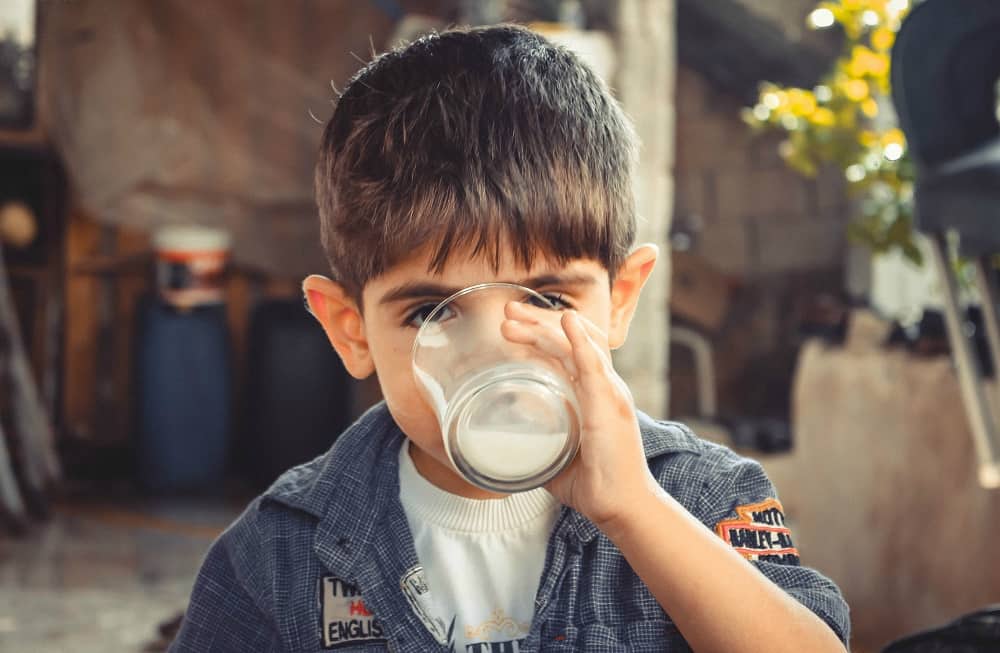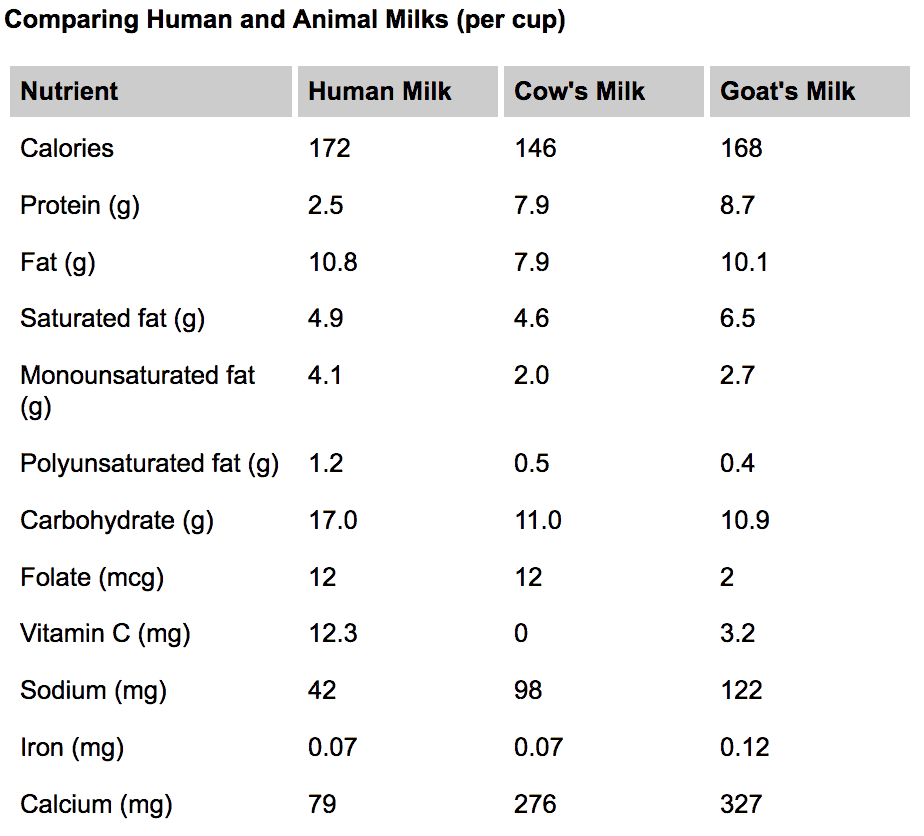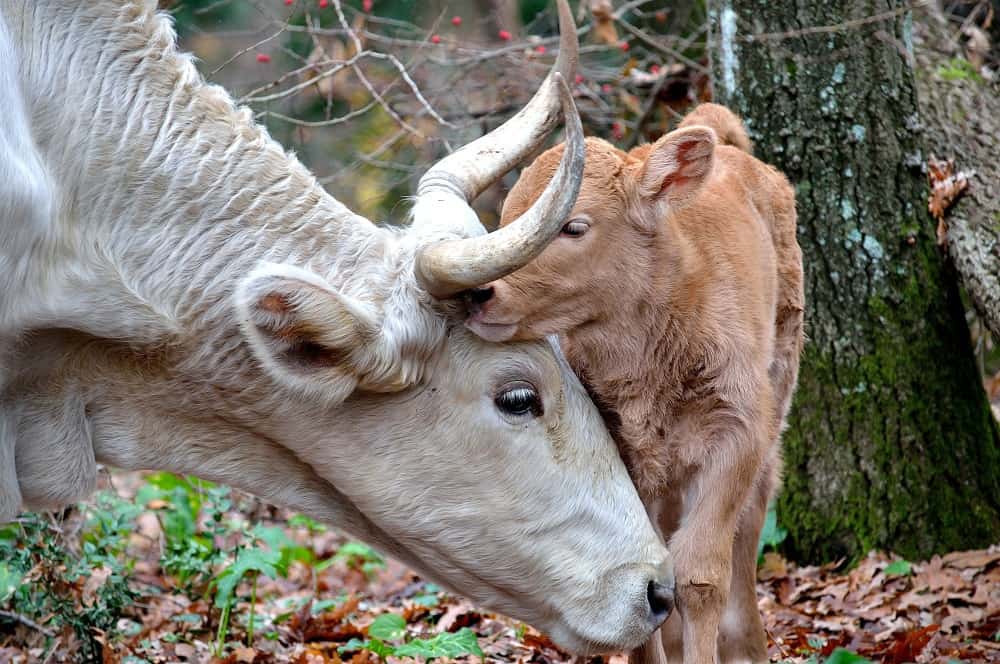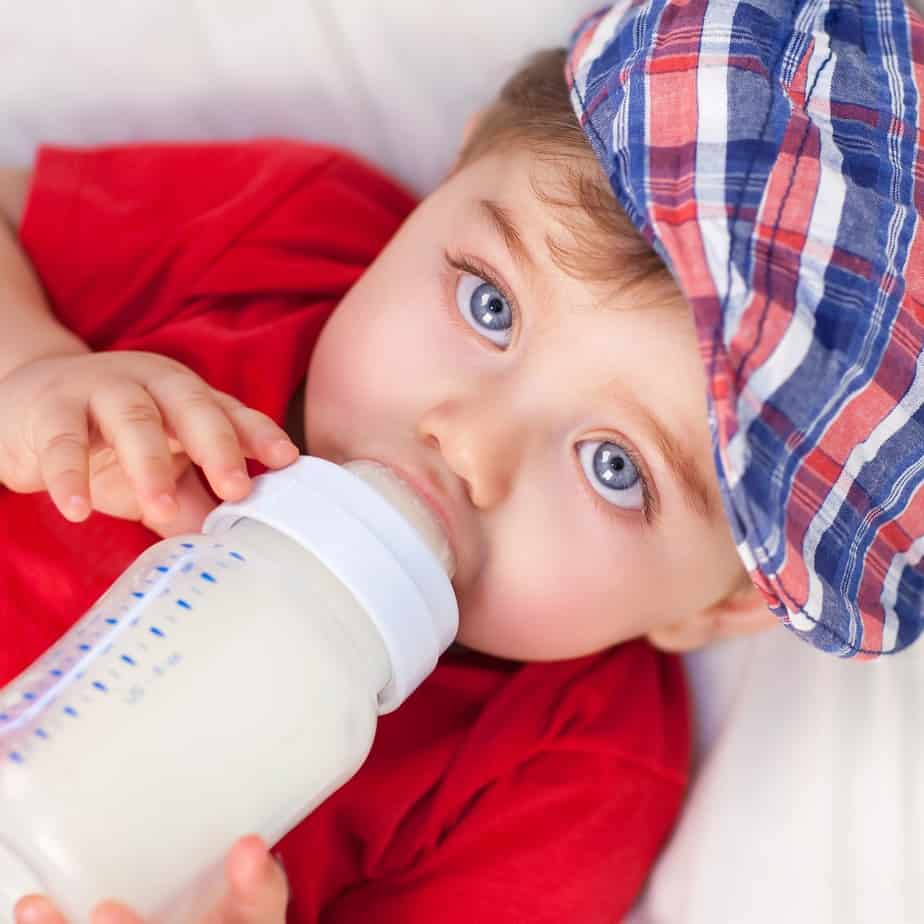Part of our job as parents is to provide our kiddos with the best start in life. In order for them to succeed and grow up healthy, we need to spend time combing through the available online information. I found this task to be particularly cumbersome with all the contradictory information about whether or not I should feed my baby cow’s milk. The following article displays the staggering research consensus that cow’s milk is unsafe for our children.
Dairy is not only unnecessary but also harmful when consumed by any species other than a baby cow. The current research overwhelmingly provides evidence linking animal milks to cancer, type I diabetes, heart disease, asthma, allergies, and more.
This article will cover such topics as:
- Origins of dairy consumption and lactose intolerance
- Comparing the composition of cow’s milk vs human milk
- Is cow’s milk necessary for human health?
- Why do our government-regulated dietary guidelines include dairy products?
- Adverse effects of drinking cow’s milk in infancy and into adulthood: bone health, anemia, asthma, allergies, diabetes, and more
- What about other dairy products, i.e. butter, cheese, and yogurt? Are these healthy?
- Additional things to consider when consuming cow’s milk
- Best Vegan sources of calcium
Parents have a million decisions to make on how to best raise their kids. These decisions become most difficult when the majority of society is leaning in one direction while your gut is pulling you in the opposite direction. Regardless of popular opinion, it is our duty as parents to become informed consumers in order to keep our children safe and well-nourished.
Starting your kids off on the right foot with healthy dietary choices is essential for fostering healthful lifelong habits surrounding food. A baby raised on cow’s milk will likely grow up to be an adult that regularly consumes cow’s milk. As you will read below, we are finally beginning to understand the devastating effects that arise from consuming the lactation secretions from another mammalian species.
Origins of dairy consumption and lactose intolerance

The domestication of animals, and consequently the consumption of animal milk appears to have originated in central Europe approximately 7,500 years ago. Historians believe people began consuming animal milk as a means to survive during extended bouts of famine. The milk provided a significant source of calories, protein, and water when freshwater and more nutritive options were unavailable.
Over the last century or so, more researchers have become interested in studying the effects of cow’s milk on human health. They discovered that, “most adults worldwide do not produce the enzyme lactase after infancy and so are unable to digest the milk sugar lactose“.
Most people of European descent, however, continue to produce lactase throughout their lives by means of a genetic mutation. Whites are more likely to have this mutation due to their long history consuming animal milk during times when resources were scarce.
Other ethnicities such as Asian, African, and Hispanic descent do not typically produce the lactase enzyme after infancy. Scientists believe they have not acquired the lactase mutation due to an insufficient length of exposure to animal milk consumption.
Those who are unable to produce this enzyme after being weaned off human breastmilk become sick when they consume milk. Today, we call the sickness “lactose-intolerance“. Symptoms can typically appear as diarrhea, gas and bloating after eating or drinking dairy products.
According to Dr. Neal Barnard, “we usually start to become lactose intolerant around six years of age to protect us from continuing to consume milk. We no longer need the lactase enzyme to break down the lactose, so our bodies gradually remove it.”

Comparing the composition of cows milk vs human milk
All mammalian milks have a slightly different composition to best provide the nutrients required by each species the milk was designed for. For instance, cow’s milk has significantly more protein than human milk because baby calves usually reach their maximum growth by two years of age and weigh on average 1,500 lbs., that’s 1 ton!
Conversely, humans reach their maximum growth between 18-19 years of age at around 115 to 170 lbs. Cow’s milk is designed to foster rapid growth in baby calves. This becomes problematic when consumed by another species who require significantly less protein and rapid growth promotion, such as the case with humans.
Another component in cow’s milk that poses an issue for human consumption is the large quantity of calcium. Yes, we all need calcium to survive. Excessive amounts of calcium, however, can be harmful.
For instance, Dr. Barnard explains how, “too much calcium makes the body reduce vitamin D activation. This is particularly alarming because vitamin D is not only necessary for skin, bone, and mental health, it is also a cancer preventer. It does this by stabilizing cells.”
Suzanne Havala, a registered dietitian from North Carolina, who was a co-author of the American Dietetic Association’s position paper on vegetarian diets, states Vegetarians get all the calcium they need from leafy vegetables, broccoli, tahini and tofu made with calcium sulfate.
Cow’s milk also has a comparably higher amount of sodium than human milk. Adding too much sodium to a baby’s diet can be harmful to his or her immature kidneys, which might not be able to process the excess salt.

Is cow’s milk necessary for human health?
“There is no need for infants [nor adults] to consume cow’s milk.”
Simply put by Dr. Neal Barnard
The nutrients in cow’s milk do not match the physiological needs of the human body. As shown in the table above, there are similar essential nutrients found in both milks that we must consume on a daily basis. But these nutrients come with great risks when obtained from animal milk sources.
Trying to consume your calcium, protein, and vitamin D from animal milk leaves you with an alarming amount of estrogens, growth factors such as IGF-1, lipids, sodium, and bacteria-laden lactation secretions.
Plant sources provide all the same nutrients gained from consuming animal milk without the harmful components listed above. Plants even provide additional healthful components that are lacking in animal milks, such as fiber, carotenoids, antioxidants, and phytochemicals.
Why do our government-regulated dietary guidelines include dairy products?
Every 5 years the USDA reviews its dietary guidelines and publishes new guidelines based on the current scientific evidence. This is particularly troublesome because the USDA is also responsible for the promotion of agribusiness, such as dairy farming. For more information on this conflict of interest click here to visit my post titled Can Vegans get Enough Protein from Their Diet? How to Tell.
In order to combat the traditionally funded science revealing the harmful outcomes of consuming cow’s milk, the dairy industry funds thousands of their own selectively conducted studies each year, (particularly near the dietary guidelines 5-year mark). These privately funded studies act to keep the public hopelessly confused about their dietary choices.
When people are confused about what they should eat based on the available information they tend to default to what they have eaten in the past. The outcome is likely more dairy consumption as opposed to healthier alternatives.
The industry carefully controls its experimental parameters by using unrealistic laboratory conditions. They also have a reputation for cherry-picking the data that supports their stance.
Through these tactics, the dairy industry continues to provide consumers with enough doubt about the healthfulness of their products to keep them returning generation after generation.
I found a great video that explains this industry-based phenomenon in greater detail. Take a look below!
The production of cow’s milk is a billion-dollar industry, These profitable businesses spend millions of dollars on marketing and advertisements every year. It is no wonder parents feel they are depriving their babies of essential nutrients if they go against the grain and choose not to give them cow’s milk.
Growing up in the middle of Dairyland
I grew up on a farm in southern Wisconsin. Milk was served at breakfast, lunch, and dinner in one form or another. As a college student, I was shocked to discover the truth about milk and its harmful effects on our health.
My parents were unintentionally putting myself and my brothers at risk by encouraging milk consumption. They were simply following what they were taught by their parents, and their parents before them. In essence, they were simply following the USDA guidelines.

(Just kidding, but I will be inserting a personal photo soon:)
Adverse effects of drinking milk in infancy and into adulthood
According to NutritionFacts.org, “giving cow’s milk to babies may have adverse long-term health effects on the infants including increased risk of childhood obesity. In some babies, cow’s milk has been linked to sudden infant death syndrome. The casomorphin in cow’s milk has been speculatively linked to autism, type I diabetes, and other disorders.“
Let’s take a look at some more specific areas of health impairment that have been linked to animal milk consumption:
Bone health claims debunked
According to the Physician’s Committee for Responsible Medicine, “when it comes to milk, research shows that dairy products have little or no benefit for bones. A 2005 review published in Pediatrics showed that milk consumption does not improve bone integrity in children.”
In another study, researchers followed 60,000 Swedish women for almost two decades and found that, “people who consumed the highest amounts of calcium did not have a reduction in bone fractures or osteoporosis. In fact, those who consumed the most calcium (more than 1,137 milligrams per day) had higher rates of hip fractures and similar rates of osteoporosis, compared with those who consumed less.”
Iron-deficiency Anemia
Iron deficiency anemia can have life-long implications on the developing infant. The anemia may result in mental, motor, and behavioral complications.
Animal milks are particularly low in iron. According to the American Family Physicians, cow’s milk should not be fed to infants at all during the first year of life due to the impacts it has on iron malabsorption in the developing child. Human milk is more bioavailable to the infant than cow’s milk, which means it is more readily absorbed and utilized by the body.
“The introduction of cow’s milk in the first year of life is the most potent dietary factor for the development of iron deficiency.” Cow’s milk is not only low in iron, but its iron is poorly absorbed. It also decreases the absorption of iron from other dietary sources.
Asthma
Dairy has recently been linked to the increasing incidence of asthmatic symptoms in children and adults. “Dairy proteins appear to trigger inflammation, apparently by triggering the release of antibodies, which leads to the constriction of the tiny muscles in the airways. By avoiding dairy proteins, the trigger for the attacks is gone,” states Dr. Neal Barnard.
“The protein in cow’s milk can be very unfriendly to the body. The casein and other proteins in cow’s milk have been associated with many medical conditions from asthma, to acne, to type-1 diabetes in children. In my experience, many patients suffering from asthmatic or allergic conditions often report dramatic relief from their symptoms upon omission of dairy products,” states Michael Klaper M.D.
Dr. Michael Greger explains that the increase in dairy and other animal products is correlated with an increase in asthma prevalence. Studies conversely show that an increase in plant foods, such as whole fruits and vegetables are associated with a decrease in asthma prevalence. Tomatoes, oatmeal, adhatoda, and black pepper, and turmeric have actually been used in the successful treatment of asthmatic symptoms.
Allergies
According to the American Academy of Allergy, Asthma, and Immunology, cow’s milk is the number one cause of food allergies in children. An estimated half of all children have an allergic response to milk.
Not only is milk one of the top allergens in the world, but it also triggers a multitude of other allergic reactions such as mucous production, upper respiratory infections, chronic coughing, sinus infections, ear infections, colic, and asthma.

Milk allergies differ from lactose intolerance in that the immune system will respond to milk as though it is a foreign invader, and will thus attack its own tissues. Lactose intolerance does not involve the immune system. Instead, lactose intolerance is caused by the inability to break down sugars found in milk due to a lack of lactase enzymes.
Typical allergic reactions to milk may manifest in the following ways:
- Hives
- Stomach upset
- Vomiting
- Bloody stools, especially in infants
- Anaphylaxis, a rare, potentially life-threatening reaction that impairs breathing and can send the body into shock
The only treatment for a milk allergy is the removal of milk and other dairy products from the diet. This includes milk, cheese, chocolate, yogurt, ice cream, and many baked goods and processed foods containing milk isolates.
Diabetes
In the first few months of life, our gut is especially leaky to proteins due to the ongoing development of the intestinal tract. Casein, the major protein found in cow’s milk, can be particularly harmful when passing through the under-developed intestinal lining.
When the proteins enter the bloodstream they trigger our immune system defenses, which proceed by attacking our own tissues in an attempt to ward off the invader. Such processes can lead to dangerous autoimmune diseases, such as Type-I diabetes.
Type-I diabetes is one of the most common chronic diseases among children today, according to the NIH. “It is characterized by the selective loss of insulin-producing pancreatic β-cells in genetically susceptible individuals.”
Ultimately, Type 1 diabetes is an autoimmune disease in which our own immune system attacks and destroys the insulin-producing cells of our pancreas. When left untreated it’s deadly, but even with well-managed insulin replacement, it may shorten life expectancy by a decade, explains Dr. Michael Greger.
According to the Physician’s Committee for Responsible Medicine, PCRM, “a Finnish study, reported in the July 30 issue of The New England Journal of Medicine, suggests that in many cases juvenile diabetes may be triggered by an immune-system response to proteins in cow’s milk in infants.
In another Finnish study involving 690 children with type-I diabetes, showed that the risk of developing the disease was doubled by the introduction of bovine milk prior to two months of age. They also determined that this early introduction of cow’s milk was the single most important risk factor in acquiring the disease.
According to the Mayo Clinic, the following signs and symptoms have been noted for Type-I diabetes in infants and toddlers:
- Increased thirst.
- Frequent urination, possibly bed-wetting in a toilet-trained child.
- Extreme hunger.
- Unintentional weight loss.
- Fatigue.
- Irritability or behavior changes.
- Fruity-smelling breath.
Other adverse responses linked to cow’s milk consumption
- Bronchitis
- Pneumonia
- Acne
- Constipation
- Hemorrhoids
- Cancer
- Heart Disease
- Other Autoimmune Diseases such as Multiple Sclerosis, Rheumatoid arthritis, Crohn’s Disease, Grave’s Disease, and Inflammatory bowel disease
What about other dairy products, i.e. butter, cheese, and yogurt? Are these healthy?
Cheese and butter are highly concentrated sources of saturated fat. Excessive fats are harmful for a number of reasons. One that may not be so obvious is added fat stores trigger the body to release more estrogens leading to reproductive cancers, such as prostate, breast, uterine, and ovarian cancer.
Low-fat and fat-free versions of dairy products are also dangerous due to the inevitable increase in protein content during the fat removal process. For more information on the harmful effects of eating too much protein you can click here to visit my post titled: Can Vegans get Enough Protein from Their Diet? How to tell.
Yogurt made from animal milks also contain harmful amounts of protein and calcium. Most commercial yogurts contain excessive amounts of added sugar, preservatives, and dyes as well. Vegan soy-based yogurts without added sugars are a great healthy alternative.
“Whether you pour it on your cereal as a liquid, churn it into butter, curdle it into yogurt, ferment it into cheese, or add sugar and freeze it to make ice cream… It’s baby calf growth fluid! ”
A wonderful reiteration by Dr. Michael Klaper

Other things to keep in mind when consuming cow’s milk
Pregnant mothers may be putting their babies at risk if they decide to consume dairy products during gestation. According to NutritionFacts.org, “when the maternal diet contains dairy products; these proteins may be absorbed and excreted intact into breast milk and may be linked to colic symptoms in infants.”
Many baby formulas also use milk protein isolates as one of the main ingredients in their products. Organic soy-based formulas are a much safer and nutritious alternative. For more information on this topic please click here to view my post on A Full Guide to Raising a Vegan or Plant-based Baby.
Best Vegan sources of calcium
As long as the plant-based breastfeeding mama or the weaned infant eat plenty of the following foods baby should have no problem getting enough calcium from his or her diet:
- legumes
- figs
- almonds
- leafy greens: kale, mustard greens, turnip greens, Swiss chard, collard greens, spinach, Chinese greens, bok choy, watercress, etc.
- tofu
- broccoli
- nut milks
- beans
- seeds
For the best vegan protein sources please click here to view my post titled Can Vegans get Enough Protein from Their Diet? How to Tell
Major takeaways on the risks of feeding cow’s milk to your children
- There is no need to incorporate cow’s milk into your child’s diet to ensure adequate health and development.
- After weaning, there is no need to include milk in the diet for any species.
- There are much healthier plant sources of calcium, protein, and fat to give your baby without the harmful saturated fats, IGF-1, hormones, and cholesterol found in animal milks.
- Animal milk can be harmful to babies and older children. They may cause conditions such as asthma, allergies, Type-I diabetes, autoimmune problems, and cancer.
- The only suitable milk for baby’s first year is breast milk or commercial formula milk if breastfeeding is not an option.
- The dairy industry has everything to gain from keeping you in the dark about the proven risks involved in consuming milk, yogurt, cheese, butter, ice cream, etc.
- Many cultures do not consume animal milk and live long healthy lives with strong bones.
- Always speak with your physician or pediatrician when making dietary changes for you or your baby.
Karli Jackson

